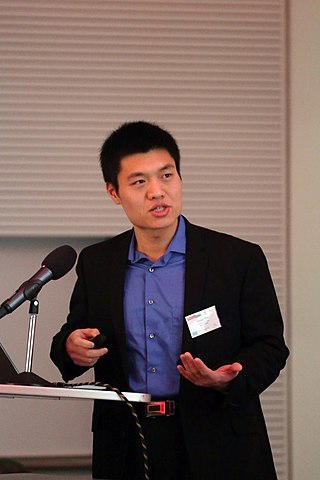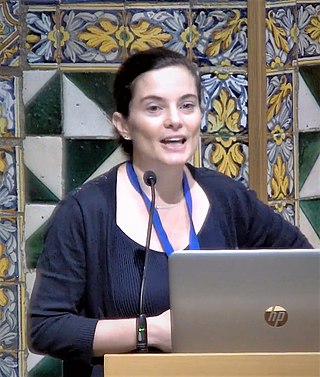Dynamic covalent chemistry (DCvC) is a synthetic strategy employed by chemists to make complex molecular and supramolecular assemblies from discrete molecular building blocks. DCvC has allowed access to complex assemblies such as covalent organic frameworks, molecular knots, polymers, and novel macrocycles. Not to be confused with dynamic combinatorial chemistry, DCvC concerns only covalent bonding interactions. As such, it only encompasses a subset of supramolecular chemistries.
Covalent organic frameworks (COFs) are a class of porous polymers that form two- or three-dimensional structures through reactions between organic precursors resulting in strong, covalent bonds to afford porous, stable, and crystalline materials. COFs emerged as a field from the overarching domain of organic materials as researchers optimized both synthetic control and precursor selection. These improvements to coordination chemistry enabled non-porous and amorphous organic materials such as organic polymers to advance into the construction of porous, crystalline materials with rigid structures that granted exceptional material stability in a wide range of solvents and conditions. Through the development of reticular chemistry, precise synthetic control was achieved and resulted in ordered, nano-porous structures with highly preferential structural orientation and properties which could be synergistically enhanced and amplified. With judicious selection of COF secondary building units (SBUs), or precursors, the final structure could be predetermined, and modified with exceptional control enabling fine-tuning of emergent properties. This level of control facilitates the COF material to be designed, synthesized, and utilized in various applications, many times with metrics on scale or surpassing that of the current state-of-the-art approaches.

Chinedum Osuji is the Eduardo D. Glandt Presidential Professor and the departmental chair of chemical and biomolecular engineering (CBE) at University of Pennsylvania. He is also a former Taekwondo Olympian and represented Trinidad and Tobago. His laboratory works on polymers and soft materials for functional application including liquid filtration. He is the associate editor of the journal Macromolecules.
William Dichtel is the Robert L. Letsinger Professor of Chemistry at Northwestern University and a 2015 MacArthur Fellow who has helped pioneer the development of porous polymers known as covalent organic frameworks. Dichtel was awarded a Guggenheim Fellowship in 2018. In 2020, Dichtel was selected as the 2020 Laureate in Chemistry of the Blavatnik Awards for Young Scientists. He also founded Cylopure, a university spin-off that seeks to bring to market water filtration with cyclodextrin polymers.
Julia Ann Kalow is an assistant professor of chemistry at Northwestern University. She is primarily a synthetic chemist, who works on polymers, photochemistry and tissue engineering. She is interested in synthetic strategies that can turn molecular structure and chemical reactivity into macroscopic properties. She has been awarded the National Science Foundation CAREER Award, Thieme Award and was selected by the University of Chicago as a Rising Star in Chemistry.
Tricia L. Carmichael is a Professor in the Department of Chemistry and Biochemistry at the University of Windsor. She develops new materials for stretchable electronics with a current focus on wearable electronic devices.

Fengqi You is a professor and holds the Roxanne E. and Michael J. Zak Chair at Cornell University in the United States. His research focuses on systems engineering and data science. According to Google Scholar, his h-index is 82.
Martha Anne Grover is an American chemical engineer who is a professor and chair of graduate studies at the Georgia Tech School of Chemical and Biomolecular Engineering. Her research considers molecular self assembly and the emergence of biological functions.
Christine Sharon Grant is an American chemical engineer who is the Associate Dean of Faculty Advancement at North Carolina State University. Her research considers surface and environmental science. She is the 2022 President of the American Institute of Chemical Engineers.
Marisa C. Kozlowski is an American chemist who is Professor of Organic and Catalysis Chemistry at the University of Pennsylvania. Her research considers asymmetric synthesis and the development of cost effective catalysts. She was elected Fellow of the American Association for the Advancement of Science in 2012 and American Chemical Society in 2013.

Clémence Corminboeuf is a Swiss chemist who is Professor of Computational chemistry at the École Polytechnique Fédérale de Lausanne. She was awarded the Swiss Chemical Society 2021 Heilbronner-Hückel Award.
Kay Michille Brummond is an American synthetic chemist who is Professor of Chemistry and Associate Dean of Faculty at the University of Pittsburgh. Her interests consider cycloaddition reactions that can realise molecules and natural products for organic photovoltaics and targeted covalent inhibitors. She was elected a Fellow of the American Chemical Society (ACS) in 2010, a Fellow of the AAAS in 2021, and awarded the ACS National Award for Encouraging Women into Careers in the Chemical Sciences in 2021.
Jennifer Schomaker is an American chemist who is a professor at the University of Wisconsin–Madison. Her research considers the total synthesis of natural and unnatural products. She was selected as an American Chemical Society Arthur C. Cope Scholar Awardee in 2021.
Xiaodong Zou is a Chinese-Swedish chemist who is a professor at Stockholm University. Her research considers the development of electron diffraction for the three dimensional characterisation of materials. She is a member of the Nobel Committee for Chemistry. She was elected to the Royal Swedish Academy of Sciences and the Royal Swedish Academy of Engineering Sciences.
Sahika Inal is a Turkish scientist who is an associate professor and Chair of the Organic Bioelectronics Laboratory at King Abdullah University of Science and Technology. She is interested in the use of organic electronic materials for monitoring health, and the design of biocompatible devices that can interface with the human body. In 2021, she was shortlisted for the Nature Portfolio Scientific Achievement award.
Song Lin is a Chinese-American organic electrochemist who is an associate professor at Cornell University. His research involves the development of new synthetic organic methodologies that utilize electrochemistry to forge new chemical bonds. He is an Associate Editor of the journal Organic Letters, and serves on the Early Career Advisory Board of Chemistry - A European Journal. He was named by Chemical & Engineering News as one of their Trailblazers of 2022, a feature highlighting LGBTQ+ chemists in academia.
Covalent adaptable networks (CANs) are a type of polymer material that closely resemble thermosetting polymers (thermosets). However, they are distinguished from thermosets by the incorporation of dynamic covalent chemistry into the polymer network. When a stimulus (for example heat, light, pH, ...) is applied to the material, these dynamic bonds become active and can be broken or exchanged with other pending functional groups, allowing the polymer network to change its topology. This introduces reshaping, (re)processing and recycling into thermoset-like materials.
Jennifer Ann Prescher is an American chemist who is a professor of chemistry at the University of California, Irvine. Her research considers the development of bioorthogonal, bioluminescent tools for the noninvasive, real-time imaging of immunometabolism. She was recognized with the 2023 American Chemical Society Arthur C. Cope Scholar Award.
Amanda Morris is an American chemist who is the Patricia Caldwell Faculty Fellow and professor of inorganic and energy chemistry at Virginia Tech. Her research considers next-generation materials for catalysis and light-harvesting. She was elected chair of the American Chemical Society Gay and Transgender Chemists and Allies committee in 2021.
Lara Ann Estroff is an American materials scientist who is a professor at Cornell University. Her research considers the study and design of biomaterials.


